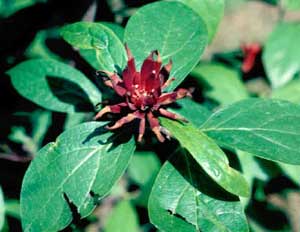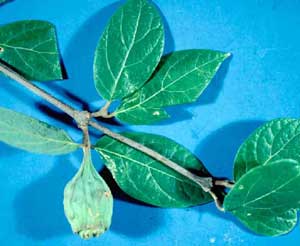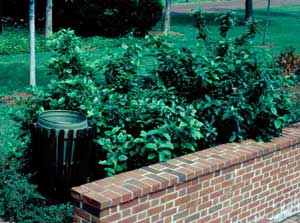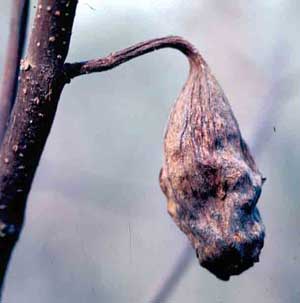Landscape Shrubs
Common Sweetshrub
(Calycanthus floridus)
Plants that have been around for a long time often become less popular for gardens, but common sweetshrub is one plant that seems to defy that logic by gaining in popularity.
While common sweetshrub (Calycanthus floridus) may not be on the tip of everyone’s tongue, it certainly should catch the attention of most gardeners as an excellent deciduous shrub. While the popularity of this plant is not debated, which common name to use might be. In addition to common sweetshrub, common names include Carolina allspice, strawberry shrub, sweet-scented shrub, Bubby blossom, Sweet Bubby, Sweet Bettie, and spicebush. Yikes!
The flower is one of the cherished ornamental features of common sweetshrub. It resembles a red radish that has been splayed on a party platter. The 1-1.5” diameter flowers first appear in mid-April and continue with significant numbers through mid-May. This first wave is followed with sporadic flowers through July. The distinctive deep blood-red flower is composed of many strap-like tepals. These strap-like structures are called tepals because we cannot easily distinguish between the petals and sepals (typically the green appendages below the colorful petals).
Of equal popularity today is a yellow-flowered cultivar called ‘Athens’ (‘Katherine’). Dr. Michael Dirr originally named this plant Katherine after his oldest daughter, but someone later changed the name to ‘Athens.’ The only other cultivar that may be found is ‘Michael Lindsey.’ It was selected for having a denser, more compact, and more rounded outline than the rest of the species.
While many gardeners claim that the flowers have a strong scent, they may be hard for some people to smell. The scent has been described as similar to strawberries—hence one common name, strawberry shrub. The fragrance changes as the flower matures. Mature flowers smell like vinegar or fermented cider. As with many other flowers, the sweet fragrance should be most obvious on a cool evening.
If you need to prune your sweetshrub you should prune immediately after flowering; most flowers are produced on previous year’s wood.
The fruit, which is rarely seen, is very odd looking. The 3” long, wrinkled urn-shaped fruit receptacle starts a soft green and fades to a leathery brown.
Nothing about sweetshrub makes this plant stand out, and the habit is certainly consistent with that claim. The plant is usually a broad shrub, 6’–7’ tall with a slightly greater spread, regular in outline, but not dense. If you want a dense, neat plant, you can certainly prune this plant frequently to achieve that look. The natural habit on this plant lends itself well to less formal, naturalized landscapes.
Leaves are a medium dark green, ovate in shape with no teeth on the margins. Fall color is occasionally yellow.
This plant has several factors working in its favor. Sweetshrub appears to be adaptable to both sun and shade and adaptable to most soils. Plants grown in dense shade will simply be less dense than sun-grown plants. Sweetshrub is not bothered by any significant disease or insect problems.
Common sweetshrub is found growing wild along the shady banks of streams from south-central Pennsylvania and southern Ohio into the Southeast. This wonderful native plant is currently being crossed with Sinocalycanthus chinensis to make hybrids with very large flowers. Watch for these interesting plants (X Sinocalycalycanthus) in your specialty nursery catalogs.
- Common Name: sweetshrub
- Varieties to look for: ‘Athens’
- Flower Color: blood red
- Blooming period: mid-April
- Type: deciduous shrub
- Size: medium; 6’ tall x 7’ wide
- Exposure: shade to sun
- Soil: amend with organic matter
- Watering: moist best
- When to prune: after flowering
- Suggested use: component of woodland garden, natural area
Leaf and flower structures

Immature fruit and leaves

Form

Mature fruit
